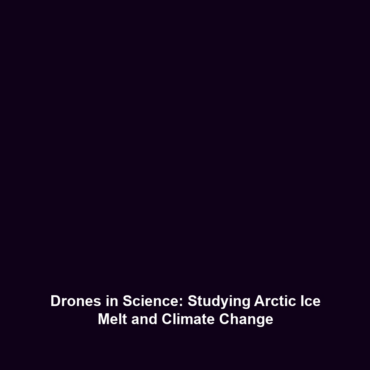Drones in Science: Examples of Drones Studying Arctic and Antarctic Ice Melt and Their Contribution to Climate Change Models
The utilization of drones in scientific research has become increasingly crucial, particularly in the context of monitoring climate change. Examples of drones studying the Arctic or Antarctic ice melt are essential tools in understanding how these environmental changes contribute to broader climate change models. These unmanned aerial vehicles (UAVs) offer unparalleled access to polar regions, allowing researchers to gather vital data on ice dynamics. This article explores the significance of drones in the study of ice melt, their key applications, the challenges they face, and the innovations shaping their future.
Key Concepts
Understanding the major concepts and principles related to drones studying ice melt is crucial for their effective application in climate science. Here are some important concepts:
1. Remote Sensing Technology
Drones equipped with advanced sensors can capture high-resolution images and atmospheric data, enabling scientists to assess ice thickness, surface temperatures, and melt patterns.
2. Data Collection and Analysis
Through the deployment of drones, researchers can collect extensive datasets which are pivotal in refining climate models and forecasting future climate scenarios related to ice melt rates.
3. Accessibility
Drones can reach remote, difficult terrains in Arctic and Antarctic regions where traditional data collection methods may be hazardous or impossible, making them indispensable in climate research.
Applications and Real-World Uses
Examples of drones studying the Arctic or Antarctic ice melt showcase their varied applications in climate science:
- Monitoring Ice Dynamics: Drones provide continuous monitoring of ice melt rates and the formation of icebergs, essential for understanding climate change impacts.
- Mapping Geographic Changes: They create detailed topographical maps that highlight changes in ice coverage over time, assisting scientists in identifying trends.
- Impact Studies: Drones are used to assess the ecological impact of ice melt on local wildlife and habitats, which correlates with broader climate models.
Current Challenges
Despite their advantages, there are several challenges in using drones for studying ice melt:
- Extreme Weather Conditions: Sample collection can be hampered by severe polar weather, limiting operational efficiency.
- Battery Life Constraints: Drones have limited flight times, which can restrict the range and duration of data collection missions.
- Data Processing Needs: The vast amounts of data generated require sophisticated processing tools and techniques, which can complicate research workflows.
Future Research and Innovations
Innovations in drone technology are paving the way for enhanced studies of ice melt:
- Next-Generation Sensors: Development of lighter sensors with enhanced capabilities could allow for more effective data collection.
- AI and Machine Learning: The integration of AI for processing data may lead to quicker and more accurate interpretations of ice melt dynamics.
- Swarm Robotics: Future research may focus on deploying multiple drones simultaneously, allowing for comprehensive assessments of larger areas.
Conclusion
In summary, drones are revolutionizing the study of Arctic and Antarctic ice melt, contributing valuable insights to climate change models. Their remote sensing capabilities and accessibility to extreme environments make them indispensable in the field of climate science. As technology advances, the effectiveness and applications of drones in understanding climate change are set to expand further. For those interested in exploring more about the role of drones in scientific research, consider visiting our Drones in Science section for further reading.
